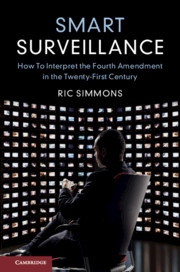Book contents
- Smart Surveillance
- Smart Surveillance
- Copyright page
- Contents
- Acknowledgments
- Introduction
- 1 The Cost–Benefit Analysis Theory
- 2 Measuring the Benefits of Surveillance
- 3 Quantifying Criminal Procedure
- 4 Reactive Surveillance
- 5 Binary Searches and the Potential for 100 Percent Enforcement
- 6 Public Surveillance, Big Data, and Mosaic Searches
- 7 The Third-Party Doctrine Dilemma and the Outsourcing of Our Fourth Amendment Rights
- 8 Hyper-Intrusive Searches
- Conclusion
- Notes
- Index
4 - Reactive Surveillance
Published online by Cambridge University Press: 02 August 2019
- Smart Surveillance
- Smart Surveillance
- Copyright page
- Contents
- Acknowledgments
- Introduction
- 1 The Cost–Benefit Analysis Theory
- 2 Measuring the Benefits of Surveillance
- 3 Quantifying Criminal Procedure
- 4 Reactive Surveillance
- 5 Binary Searches and the Potential for 100 Percent Enforcement
- 6 Public Surveillance, Big Data, and Mosaic Searches
- 7 The Third-Party Doctrine Dilemma and the Outsourcing of Our Fourth Amendment Rights
- 8 Hyper-Intrusive Searches
- Conclusion
- Notes
- Index
Summary
Chapter 4 discusses the topic of reactive surveillance, such as thermal imagers, decryption tools, and devices that reveal the phone numbers that are being dialed on a telephone. These are tools which the government needs in order to respond to privacy-enhancing technology used by private citizens. Although reactive surveillance tools can be very intrusive in some ways, in most contexts they are only being used to learn information that would ordinarily be public, but has been hidden by new forms of privacy-enhancing technology, such as heat lamps, encryption tools, and cell phones. In evaluating reactive surveillance, we need to consider both the level of criminal activity that is potentially masked by the privacy-enhancing technology, and how the privacy-enhancing technology has affected society’s expectations of privacy. In the context of encryption, we need to assist law enforcement even further, by creating a key escrow system which will give law enforcement the ability to decrypt any piece of data once they have obtained the proper legal authority
Keywords
- Type
- Chapter
- Information
- Smart SurveillanceHow to Interpret the Fourth Amendment in the Twenty-First Century, pp. 84 - 101Publisher: Cambridge University PressPrint publication year: 2019

